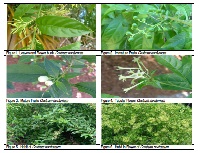Evaluation of anticoagulant activity of aqueous extract of Cestrum nocturnum
Keywords:
Anticoagulant, Thromboplastin Time, Prothrombin, Cestrum nocturnumAbstract
The study evaluated anticoagulant properties of the aqueous extract of Cestrum nocturnum using aPTT-Activated Partial Thromboplastin Time, PT- Prothrombin Time & TT-Thrombin Time as standard procedures. For in vitro coagulation assays, aqueous extract of plant prolonged APTT, TT, and PT clotting times in a dose-dependent manner (Table 7). It prolonged APTT clotting time from 45 ± 2 (2mg/mL) to 82.2 ± 2.63s (10mg/mL), PT clotting time from 20.4 ± 1.49 (2mg/mL) to 31.4 ± 2.15s (10mg/mL), and TT clotting time from 9.2 ± 1.16 (2mg/mL) to 17.4 ± 1.01s (10mg/mL) at the concentration of 2 to 10mg/mL. Heparin prolonged APTT and PT clotting times more than 111.8s and 40.8s, respectively, at a concentration of 1 IU/mL. Heparin prolonged TT clotting times more than 20.6s at a concentration of 1 IU/mL. The phytochemical screening of the plant confirm the presence of saponin in the water and ethanolic extract, Alkaloid in all the extract except hexane extract, tannin in water, ethanol and methanol extract, amino acid in water and ethanolic extract, carbohydrate in water and methanolic extract and triterpenoids and glycoside were absent in all the extracts. The results demonstrated that the aqueous extract of Cestrum nocturnum possesses pharmacologically active anticoagulant principles that could be isolated and evaluated for clinical or physiological purposes.
References
. Baquar SR. The role of traditional medicine in rural environment. In: Issaq S (ed) Traditional Medicine in Africa. East Africa Educational Publishers Ltd., Nairobi 1995; 141-142.
. Abalson PH. Medicine from plants. Science, 1990; 247: 513-519.
. Lanfranco G. Invited review article on traditional medicine. Electronic Journal of Biotechnology1999; 2: 1-3.
. World Health Organization. General Guidelines for Methodologies on Research and Evaluation of Traditional Medicine. WHO, Geneva, Switzerland 2001;1.
. Edoega HO, Mbaeble BO, Okwu DE. Phytochemical constituents of some Nigerian medicinal plants, African Journal of Biotechnology. 2005; 4:685-688.
. Rahman KH, Billington D. Dietery supplementation with aged garlic extract inhibits ADP-induced platelet aggregation in humans. Human nutrition and metabolism research communication. 2000;130: 2662-2665.
. Dutta-Roy AK, Crosbie L, Gordon, MJ. Effect of tomato extract on human platelet aggregation in vitro, Platelet. 2001;12: 218-227.
. Hutchings A. Zulu medicinal plants: an inventory, 1sted, PMB University of Natal Press 1996.
. Ichinose A. Multiple members of the plasminogen-apolipoprotein (a) gene family associated with thrombosis. Biochemistry, . 1992; 31, 3113–3118.
. Sofoware A. Medicinal plants and traditional medicine. Spectrum books Ltd. Ibadhan, Nigeria: 1993; 289.
. Amrani S, Harnafi H, Gadi D, Mekhfi H, Legssyer A, Aziz M, Martin-Nizard F, Bosca L. Vasorelaxant and anti-platelet aggregation effects of aqueous Ocimum basilicum extracts. Journal of Ethnopharmacology 2009; 125(1): 157-162.
. Gadi D, Bnouham M, Parsley extracts inhibits in vivo and ex vivo platelet aggregation and prolongs bleeding time in rats, Journal of ethnopharmacology. 2009;125:170-174.
. Lau AJ, Toh DF, Chua TK, Pang YK, Woo SO, Koh HL. Antiplatelet and antiocoagulant effects of Panax notoginseng. . Journal of Pharmacology. 2009;125: 380-38.
. Goldhaber SZ. Morrison RM. Pulmonary embolism and deep vein thrombosis. Circulation. 2002;106: 1436–1438.
. Van Wyk B-E, Van Oudtshoom B, Gerike N. Medicinal plants of South Africa, Briza, Pretoria. (1997); 8(12) 14-20.
. Cooper EL, Drug discovery, CAM and natural products. eCAM 2001;1: 215-217.
. Lindequist U, Niedermeyer T, Jülich WD. The pharmacological potential of mushrooms. eCAM, 2005; 2: 285-299.
. Rashid HU, Rahman MA, Sultana R, Bin Emran T, Islam MS, Chakma JS, Hasan CM. Effects of organic extracts of six Bangladeshi plants on in vitro thrombolysis and cytotoxicity. BMC Complement Altern Med. 2013;13, 25.
. Sahane RS, Wankhade PA, Shrungarpure MA. Pharmacological and phytochemical investigation of Cestrum nocturnum leaf extract for antihyperglycemic and antihyperlipidemic activity. International Journal of Research in Pharmacology &Pharmacotherapeutics, 2014;4, 255-268.
. Kokate CK. A text book of Practical pharmacognosy. 5thEdition,VallabhPrakashan New Delhi: 2005;107-111.
. Mao W, Li H, Li Y, Zhang H, Qi X, Sun H, Chen Y, Guo S. Chemical characteristic and anticoagulant activity of the sulfated polysaccharide isolated from Monostromalatissimum (Chlorophyta). Int J BiolMacromol, 2009,44:70–74.



